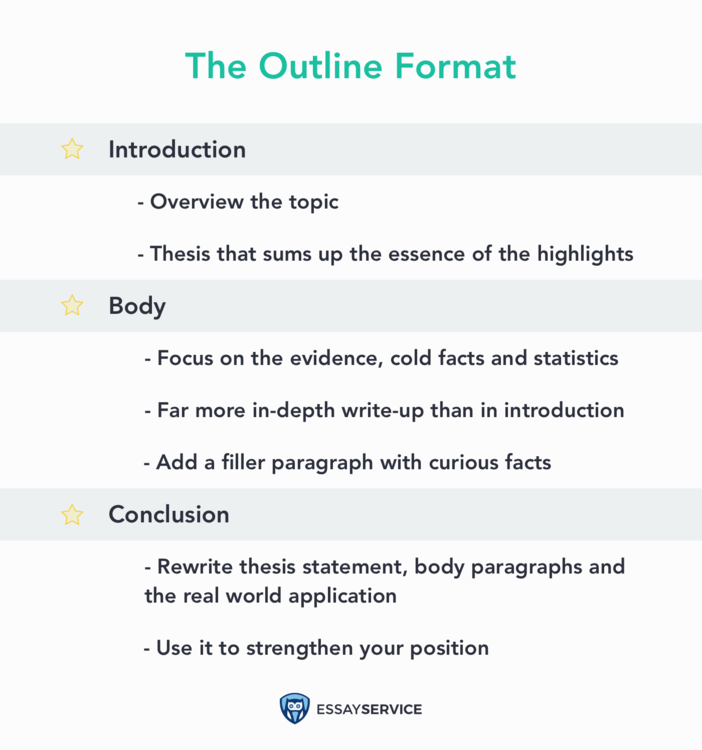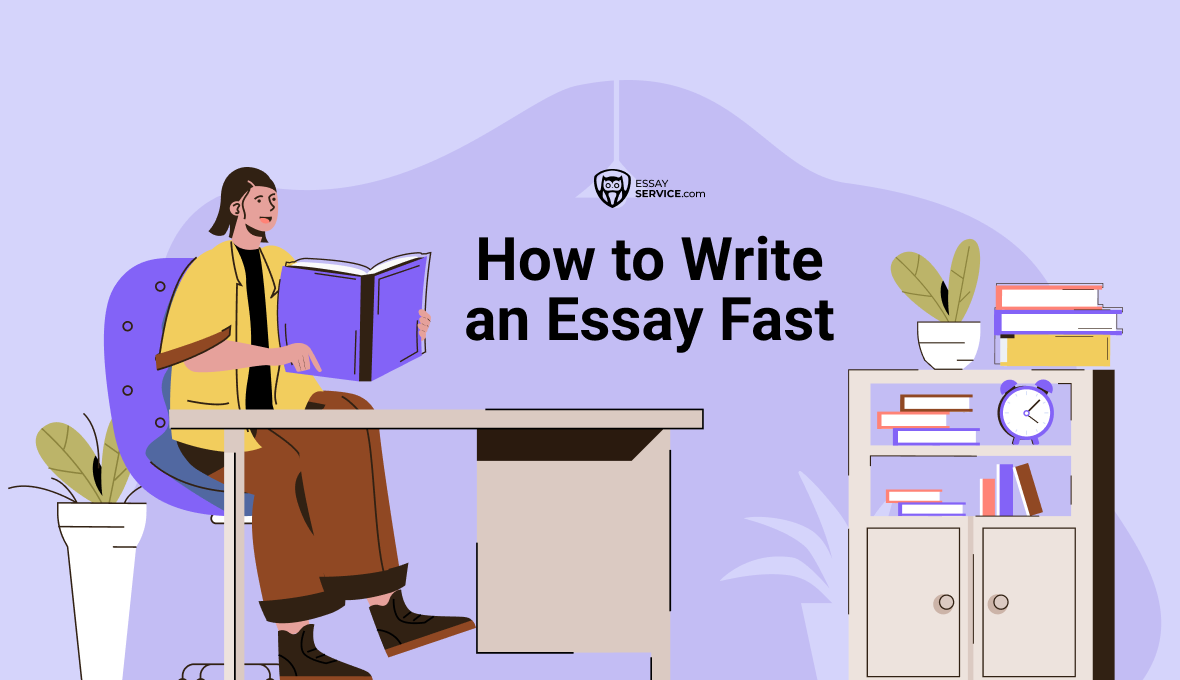.webp)
How to Write an Essay Outline: Easy-to-Follow Tips For Building a Strong Academic Foundation
Starting an essay can be a bit overwhelming, right? But don't worry! This article is here to make your life easier. We're diving into the nitty-gritty of creating an essay outline – your go-to tool for getting thoughts in order and making your essay shine. So, let's break it down and make the essay-writing journey a whole lot smoother. Ready? Let's go!
What Is an Essay Outline?
An essay outline is like a roadmap that guides you through the writing process by organizing your thoughts and structuring your ideas before you start writing. It typically consists of a series of headings and subheadings that outline the main points and supporting details of your essay. Think of it as a skeleton for your essay, providing a framework that helps you stay focused and ensures that your arguments flow logically from one point to the next. With the help of essay outlines, students can see the overall paper’s structure and identify any gaps or areas that need further development, making the writing process more efficient and effective. Note that every qualified essay writer draws up an outline as a part of their assignment.
How to Make an Essay Outline: Content Plan
- Essay outline definition and importance.
- Essay outline purpose.
- How to produce an essay outline.
- Structure, format, and examples.
- Argumentative.
- Persuasive.
- Narrative.
- Compare and Contrast.
- Cause and Effect.
- Informative.
Why It’s Important to Write an Outline?
Writing an essay outline is a crucial step for students due to its role in enhancing organization and clarity of thought. The outline acts as a structural scaffold, guiding students in arranging their ideas in a logical sequence. By delineating the main points and supporting details, an outline ensures that the essay flows smoothly, preventing the development of disjointed or haphazard content. This organizational aspect aids in presenting a coherent and well-structured argument, ultimately contributing to a more compelling and effective essay.
Additionally, an essay outline facilitates time management and the prevention of redundancy. Through careful planning at the outlining stage, students can allocate their time efficiently during the writing process, focusing on key elements without meandering. The outline also serves as a preemptive measure against unnecessary repetition or superfluous content, as students can identify and address these issues before delving into the actual composition. Need help with any specific part of your homework? Use our custom essay writing service to wrap the task up faster and receive a higher grade.
Essay Outline Structure
A typical essay outline comprises three fundamental parts: the introduction, body paragraphs, and conclusion. Students who pay for essays on our website receive fully submission-ready documents with a rigid structure. The introduction section outlines the essay's main topic, presents a thesis statement that encapsulates the central argument and may include a brief overview of key points.
The body paragraphs follow, each dedicated to a specific idea or argument, with topic sentences introducing the main point and supporting details or evidence. These paragraphs collectively build a cohesive argument. The conclusion summarizes the key points, restates the thesis, and provides a sense of closure, leaving a lasting impression on the reader. This tripartite structure ensures a well-organized and coherent outline, guiding students in systematically developing their ideas. To help you better understand the material, here’s an outline essay example:
- Introduction. In the introduction, grab your reader's attention with a captivating hook, like a question or quote. Offer a brief background to set the context, and conclude with a clear thesis statement that outlines your essay's main argument or purpose.
- Main Body. The main body is where you develop your ideas. Start each paragraph with a strong topic sentence, followed by supporting evidence such as examples or data. Analyze and explain the evidence, ensuring a smooth transition between paragraphs.
- Conclusion. Wrap up your essay by restating your thesis, summarizing the main points without being redundant. Conclude with a powerful closing statement that leaves a lasting impression, whether it's a call to action or a thought-provoking idea.
Sounds a bit complicated? Use our essay writing service to put your finger on any time-tacking or mind-boggling school or college assignment.

A Deeper Look in the Outline Format
When preparing to write an essay, think of the outline as a game plan. It's your writing protocol that helps you figure out where to start and how to organize your ideas. Just like a recipe tells you what ingredients you need and the steps to follow, an outline breaks down your essay into manageable parts. In this section, we're going to talk about how to make this game plan and your outline so you can tackle your essay with confidence and make sure it all makes sense. It's like having a cheat sheet on how to write an outline for an essay that keeps you on track as you write – simple as that!
Introduction
The introduction of your essay serves as the gateway to your ideas. Begin with a compelling hook, such as a captivating question, an intriguing quote, or a thought-provoking anecdote, to immediately engage your reader. Following this, provide some context or background information to set the stage for your discussion. Finally, crystallize your essay's purpose with a clear and concise thesis statement, which should encapsulate the main argument or stance you'll be exploring in the subsequent paragraphs.
Main Body
In the main body of your essay, each paragraph should revolve around a central theme introduced by a strong topic sentence. This sentence acts as a guide, signaling the main idea to the reader. Subsequently, support your assertions with relevant evidence, examples, or data. Ensure a smooth transition between paragraphs by linking your ideas logically. Use this section to thoroughly explore and develop your arguments, providing ample detail and analysis. Remember to maintain a clear focus on your thesis throughout the main body. If the deadline is too short, simply type, ‘write my essay for me,’ and our writers will assist you in no time.
Conclusion
The conclusion serves as the closing act of your essay, and it's your chance to leave a lasting impression. Begin by summarizing the main points of your essay, reinforcing the key arguments presented in the main body. Restate your thesis, but avoid simply copying and pasting; instead, rephrase it to underscore the journey your essay has taken. Finally, conclude with a powerful closing statement that leaves the reader with something to ponder, whether it's a call to action, a broader implication, or a thought-provoking idea that lingers beyond the final words.

Essay Outline Example
As you’ve covered the basics, let’s review the essay outline template you can use for writing literally any composition:
Introduction
- Hook. Engaging statement, question, quote, or anecdote.
- Background information. Brief context or historical overview.
- Thesis statement. Clear and concise main argument or purpose of the essay.
Body Paragraphs
- Topic Sentence. Introduces the main idea of the paragraph.
- Supporting Evidence. Provide examples, data, quotes, or details that support the topic sentence.
- Explanation. Analyzes and interprets the evidence, explaining its significance.
- Transition. Connects the current paragraph to the next one.
Counterargument
- Refutation. Present arguments against the counterargument.
- Reiteration of thesis. Emphasize the strength of the main argument.
Conclusion
- Restate thesis. Summarize the main argument.
- Summary of main points. Recap the key supporting points.
- Closing statement. Conclude with a thought-provoking idea, call to action, or broader implications.
Should you need a new paper written quickly according to this structure, use our online paper writing service. It is fast, safe, and gets the job done.
How to Draw up an Essay Outline in 4 Steps
Writing an essay outline consists of four steps and is actually easier than you think. Check out this simple step-by-step guide, and you’ll be able to create outlines for any type of assignment.
Step 1: Introduction
Begin your essay outline by crafting a compelling introduction. Clearly state your thesis or main argument, providing a brief overview of the topic and its significance. Consider including a hook or engaging anecdote to captivate the reader's attention and set the tone for your essay.
Step 2: Main Arguments and Supporting Points
Identify the key arguments that support your thesis. Each argument should have its own section in the outline. Develop these sections by providing supporting points, evidence, or examples that bolster your claims. Ensure a logical flow between arguments, building a coherent and persuasive narrative. This step is perhaps the hardest for students to comprehend, which is why we recommend to buy an essay in order to prevent you from burnout and writer’s block.
Step 3: Counterarguments and Rebuttals
Acknowledge potential counterarguments to your main points. Dedicate a section of your outline to address these opposing perspectives. Develop thoughtful rebuttals that strengthen your position and demonstrate a nuanced understanding of the topic. This step adds depth to your essay and showcases your ability to consider multiple viewpoints.
Step 4: Conclusion
Craft a concise and impactful conclusion that summarizes your main arguments and reinforces your thesis. Avoid introducing new information in the conclusion and instead focus on leaving a lasting impression on the reader. Conclude with a thought-provoking statement, a call to action, or a connection to broader implications related to your topic. Ensure your conclusion resonates with the reader and reinforces the significance of your essay's message.
Structure of an Essay
Argumentative Essay Structure
In an argumentative essay, the structure presents a clear thesis statement in the introduction, followed by body paragraphs that each focus on a distinct supporting argument. The essay progresses logically, with counterarguments and rebuttals integrated to strengthen the overall position. The conclusion consolidates the main arguments, reaffirms the thesis, and leaves the reader with a compelling takeaway.
Learn more about how to write an argumentative essay.
Persuasive Essay Structure
A persuasive essay employs a structure centered on convincing the audience to adopt a specific viewpoint or take a particular action. The introduction establishes the issue and introduces a clear thesis, followed by body paragraphs that present persuasive evidence and reasoning. Emphasis is placed on rhetorical devices and emotional appeal to engage the reader. The conclusion reinforces the persuasive elements and prompts the audience to reflect on the presented ideas.
Learn more about how to write a persuasive essay.
Narrative Essay Structure
In a narrative essay, the structure is characterized by a storytelling approach. The introduction sets the scene and introduces a central theme or event. Body paragraphs develop the narrative, sequentially presenting events and experiences. The climax, often located towards the essay's middle, builds tension or reveals a turning point. The conclusion resolves the narrative, reflecting on its significance or conveying a lesson learned.
Learn more about how to write a narrative essay.
Compare and Contrast Essay Structure
A compare and contrast essay employs a structure that juxtaposes similarities and differences between two or more subjects. The introduction introduces the subjects and establishes the purpose of the comparison. Body paragraphs alternate between discussing similarities and differences, with clear transitions to maintain coherence. The conclusion summarizes key points and highlights the overall significance of the comparisons made.
Learn more about how to write a compare and contrast essay.
Cause and Effect Essay Structure
The structure of a cause and effect essay focuses on exploring the relationships between events or phenomena. The introduction identifies the main cause or effect and introduces the thesis statement. Subsequent body paragraphs delve into the causes or effects, providing evidence and analysis. The conclusion summarizes the key causal links and reinforces the broader implications or significance of the explored relationships.
Learn more about how to write a cause and effect essay.
Informative Essay Structure
An informative essay structure revolves around presenting factual information in a clear and organized manner. The introduction outlines the topic and provides a thesis statement that previews the key points to be covered. Each body paragraph addresses a specific aspect or subtopic, supported by evidence or examples. The conclusion summarizes the main points and often suggests further areas of exploration, leaving the reader with a comprehensive understanding of the subject.
Learn more about how to write an informative essay.
Final Word
Understanding how to write an essay outline offers students several advantages. Firstly, it helps them organize their thoughts in a logical and clear manner, making the writing process smoother. With a structured outline, students can see the flow of their ideas and ensure that each point supports their thesis effectively. Secondly, having an outline acts as a guide, preventing students from feeling overwhelmed or lost in their writing. It helps them stay focused on their main arguments and ensures they don't stray off-topic. Ultimately, the knowledge of essay outlining equips students with a valuable tool that enhances their writing skills and academic performance. If you’ve been considering getting an extra pair of hands working on your tasks, have a look at essay services reviews and choose the one that fits your goals and budget.
Frequently asked questions
How to Write an Essay Outline?
Begin with a compelling introduction, clearly state your thesis, and provide a brief overview of the topic. Identify and develop key arguments in separate sections of the outline, supporting them with relevant evidence and examples. Address potential counterarguments and incorporate rebuttals to strengthen your position. Conclude with a concise summary that reinforces your thesis and leaves a lasting impression on the reader. A well-constructed essay outline not only serves as a roadmap for the writing process but also enhances the clarity and coherence of your final essay.
What Part of Your Research Essay Should You Outline First?
It's advisable to start with the introduction. This sets the tone for your entire paper, introducing the topic, providing context, and presenting the thesis statement. By crafting a well-structured introduction, you establish a solid foundation for the rest of your essay. It guides your subsequent outline sections, ensuring that each part contributes cohesively to the overall argument. Starting with the introduction allows you to clarify your main ideas and create a roadmap for the reader, making the entire research essay more accessible and engaging.
In a Preparation Outline Following a Standard Format, Where Are Two Places Labels Could Appear?
Labels can appear in two prominent places: first, within the main body of the outline, where each section and subsection is labeled with Roman numerals, letters, or numbers to indicate the hierarchy of ideas. These labels help organize and structure the content, providing a clear visual guide for the essay's development. Second, labels are also commonly used in the header or title section of the outline, where the title of the essay and additional identifying information, such as the author's name or date, are labeled for clarity. Both instances of labeling contribute to the overall organization and coherence of the preparation outline.
New posts to your inbox!
Your submission has been received!



.webp)